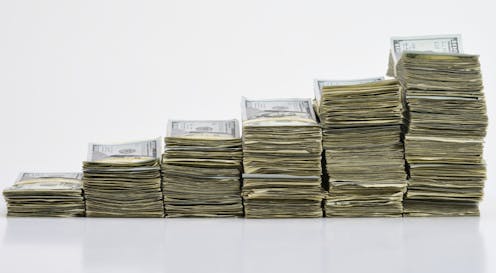Yes, US economy may be slowing, but don't forget it's coming off the hottest year since 1984 – here'
Most of the gains went to the richest Americans, but almost everyone saw an improvement in terms of net wealth.

The U.S. economy unexpectedly shrank in the first quarter, according to gross domestic product data released on April 28, 2022. While the reasons were technical and weren’t seen as signs of weakness, they add to worries that the U.S. might be headed for another recession as the Federal Reserve seeks to fight inflation by raising interest rates.
But before we fret too much about what 2022 will bring, I believe, as a financial economist who studies the decisions people and companies make with money and the resulting impacts, it’s worth reflecting on 2021, which saw the strongest economic growth in almost four decades.
GDP, which provides a snapshot of the economy by measuring the total value of all goods and services consumers produce and exchange, surged 5.7% in 2021 after accounting for inflation, the fastest pace since 1984.
So who benefited from all this growth?
Record gains in American net worth
A useful way to assess how economic growth affects individuals is by looking at personal financial wealth. This is measured by net worth, or the difference between what someone owns and owes.
By that measure, it’s likely that the vast majority of Americans are better off than they were in 2020 – or even before the COVID-19 pandemic – meaning they have less debt relative to their assets. This is in no small part thanks to the trillions of dollars in pandemic-related spending by the U.S. government.
Overall, Americans’ net worth increased by over US$18 trillion during 2021 to $142 trillion, likely the biggest increase ever.
It amounts to an average gain of almost $55,000 for every American.
The wealthiest got most of that
Of course, the average hides tremendous variation across groups.
It’s already been thoroughly reported that billionaires saw their wealth soar during the pandemic. This was driven largely by double-digit gains in the value of their stock holdings and businesses, while their liabilities grew only 1%.
In 2021, the wealthiest 1% of Americans saw their net worth grow $6.7 trillion to about $46 trillion, making up well over a third of the overall gains. Another $6.2 trillion went to the next 9%. Meanwhile, just $1.5 trillion went to the bottom 50%.
But those in the bottom half grew the fastest
The richest may have gotten the most, but the net wealth of the bottom half jumped at the fastest pace.
The bottom 50% saw their wealth grow 64% in 2021. That’s the biggest calendar-year growth of any of these groups since at least 1988, dwarfing the percentage gains of the richest.
This happened largely because homeowners saw real estate assets grow a lot faster than mortgage debts.
While these changes are positive for Americans, both on average and in general, this has not changed the overall distribution of wealth that much.
The bottom half of Americans accounted for 5.5% of the country’s assets before the pandemic and at the end of 2021 owned 5.9%. Though this is the highest level since 2013, it still lags behind levels it saw during the 1990s, when the share rose to nearly 9%.
White people gained most, but still saw share fall
Similar to the income-level story, most of the gains went to white Americans, who saw their net wealth soar $14.5 trillion in 2021 to $119 trillion. Black Americans gained $1.3 trillion, and Hispanics saw growth of $683 billion.
But the percentage gains were highest for people of color – 26% for African Americans and 24% for Hispanics. That compares with 14% for white Americans.
As a result, the overall share held by white people fell to 83.6%, the lowest since at least 1988 and very likely the lowest ever. Black net wealth increased to 4.4% of the pie, the most since 1992. Hispanics held 2.5% of total U.S. net wealth.
For context, non-Hispanic white Americans make up about 60% of the population, versus 13.4% for Black Americans and 18.5% for Hispanic or Latino Americans.
What happens next, as economic growth slows, is hard to say. A large chunk of the coronavirus-related aid went to poorer Americans, which helps explain the gains for the bottom 50% as well as for Black people and Latinos. That aid has now ended.
Still, the market for workers remains on fire, with unemployment at 3.6% at the end of March 2022, near a half-century low. And economists have been forecasting pretty solid growth.
Will this strong economic growth continue?
Count me as one economist hoping Americans continue benefiting from improving job prospects to build wealth – even as the economic picture gets a bit cloudier.
[More than 150,000 readers get one of The Conversation’s informative newsletters. Join the list today.]
D. Brian Blank ne travaille pas, ne conseille pas, ne possède pas de parts, ne reçoit pas de fonds d'une organisation qui pourrait tirer profit de cet article, et n'a déclaré aucune autre affiliation que son organisme de recherche.
Read These Next
How the ‘slayer rule’ might play a role in determining who will inherit wealth from Rob Reiner and h
These rules have a long history in the United States. They played a role in the notorious murders by…
The celibate, dancing Shakers were once seen as a threat to society – 250 years later, they’re part
‘The Testament of Ann Lee,’ Mona Fastvold’s 2025 film, depicts part of the long history of Shaker…
From truce in the trenches to cocktails at the consulate: How Christmas diplomacy seeks to exploit s
World leaders like to talk up peace at Christmastime. But alongside the tales of seasonal breaks in…






